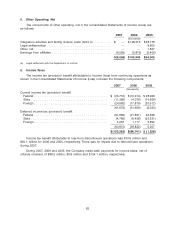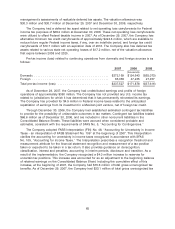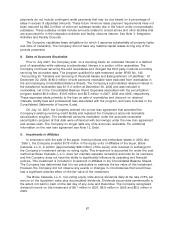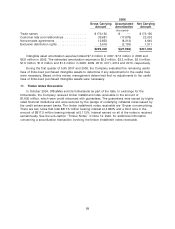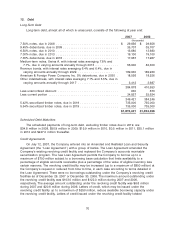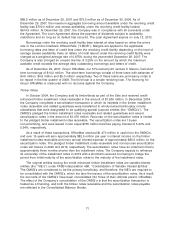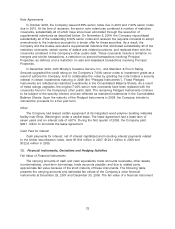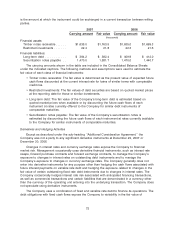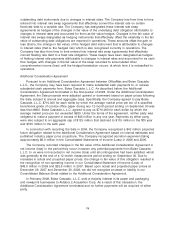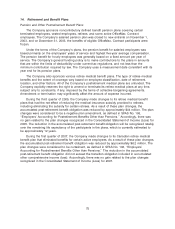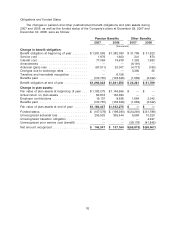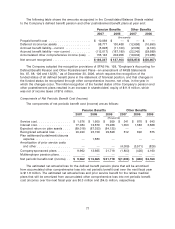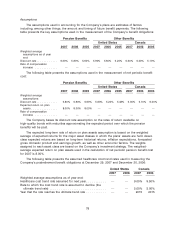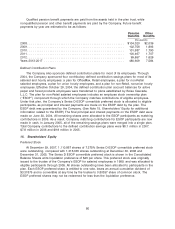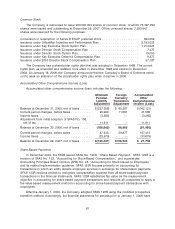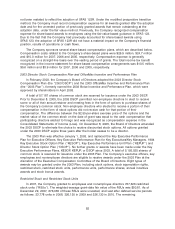OfficeMax 2007 Annual Report Download - page 76
Download and view the complete annual report
Please find page 76 of the 2007 OfficeMax annual report below. You can navigate through the pages in the report by either clicking on the pages listed below, or by using the keyword search tool below to find specific information within the annual report.Note Agreements
In October 2003, the Company issued 6.50% senior notes due in 2010 and 7.00% senior notes
due in 2013. At the time of issuance, the senior note indentures contained a number of restrictive
covenants, substantially all of which have since been eliminated through the execution of
supplemental indentures as described below. On November 5, 2004, the Company repurchased
substantially all of the outstanding 6.50% senior notes and received the requisite consents to adopt
amendments to the indenture pursuant to a tender offer for these securities. As a result, the
Company and the trustee executed a supplemental indenture that eliminated substantially all of the
restrictive covenants, certain events of default and related provisions, and replaced them with the
covenants contained in the Company’s other public debt. Those covenants include a limitation on
mergers and similar transactions, a restriction on secured transactions involving Principal
Properties, as defined, and a restriction on sale and leaseback transactions involving Principal
Properties.
In December 2004, both Moody’s Investors Service, Inc., and Standard & Poor’s Rating
Services upgraded the credit rating on the Company’s 7.00% senior notes to investment grade as a
result of actions the Company took to collateralize the notes by granting the note holders a security
interest in certain investments maturing in 2008 (the ‘‘Pledged Instruments’’). These Pledged
Instruments are reflected as restricted investments in the Consolidated Balance Sheets. As a result
of these ratings upgrades, the original 7.00% senior note covenants have been replaced with the
covenants found in the Company’s other public debt. The remaining Pledged Instruments continue
to be subject to the security interest, and are reflected as restricted investments in the Consolidated
Balance Sheets. Upon the maturity of the Pledged Instruments in 2008, the Company intends to
reinvest the proceeds for a five year term.
Other
The Company had leased certain equipment at its integrated wood-polymer building materials
facility near Elma, Washington under a capital lease. The lease agreement had a base term of
seven years and an interest rate of 4.67%. During the first quarter of 2006, the Company paid
$29.1 million to terminate the lease agreement.
Cash Paid for Interest
Cash payments for interest, net of interest capitalized and including interest payments related
to the timber securitization notes, were $116.6 million in 2007, $124.1 million in 2006 and
$122.6 million in 2005.
13. Financial Instruments, Derivatives and Hedging Activities
Fair Value of Financial Instruments
The carrying amounts of cash and cash equivalents, trade accounts receivable, other assets
(nonderivatives), short-term borrowings, trade accounts payable, and due to related party,
approximate fair value because of the short maturity of these instruments. The following table
presents the carrying amounts and estimated fair values of the Company’s other financial
instruments at December 29, 2007 and December 30, 2006. The fair value of a financial instrument
72


